Résultats de la recherche pour "python OR 3 OR for OR science OR and OR engineering OR applications"
-
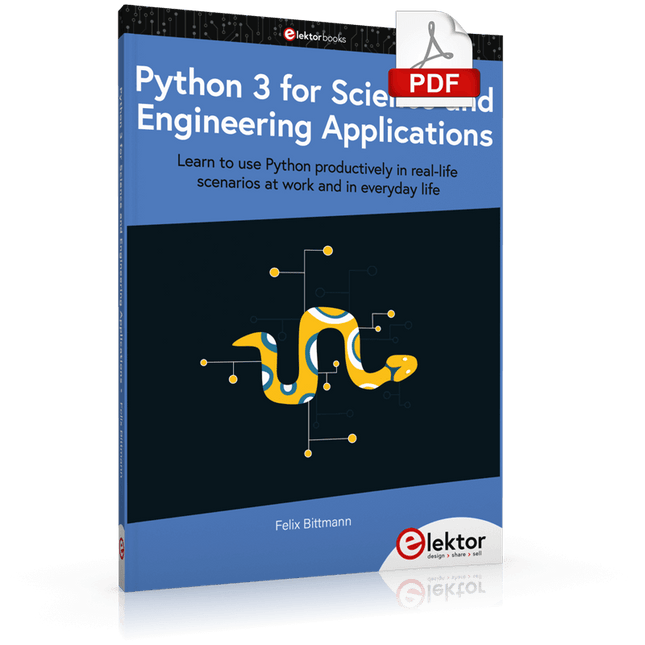
Elektor Digital Python 3 for Science and Engineering Applications (E-book)
Learn to use Python productively in real-life scenarios at work and in everyday life If you have mastered the basics of Python and are wanting to explore the language in more depth, this book is for you. By means of concrete examples used in different applications, the book illustrates many aspects of programming (e.g. algorithms, recursion, data structures) and helps problem-solving strategies. Including general ideas and solutions, the specifics of Python and how these can be practically applied are discussed. Python 3 for Science and Engineering Applications includes: practical and goal-oriented learning basic Python techniques modern Python 3.6+ including comprehensions, decorators and generators complete code available online more than 40 exercises, solutions documented online no additional packages or installation required, 100% pure Python Topics cover: identifying large prime numbers and computing Pi writing and understanding recursive functions with memorisation computing in parallel and utilising all system cores processing text data and encrypting messages comprehending backtracking and solving Sudokus analysing and simulating games of chance to develop optimal winning strategies handling genetic code and generating extremely long palindromes Downloads Software
€ 29,95
Membres € 23,96
-
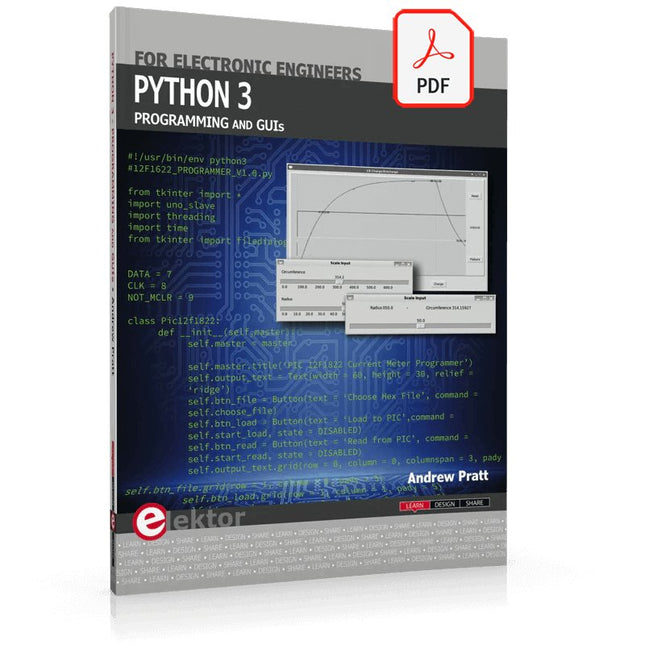
Elektor Digital Python 3 Programming and GUIs (E-book)
This is the second edition of a book aimed at engineers, scientists, and hobbyists who want to interface PCs with hardware projects using graphical user interfaces. Desktop and web-based applications are covered. The programming language used is Python 3, which is one of the most popular languages around: speed of programming being a key feature. The book has been revised and updated with an emphasis on getting the user to produce practical designs with ease – a text editor is all that is required to produce Python programs. Hardware interfacing is achieved using an Arduino Uno as a remote slave. A full description and source code of the communication interface is given in the book. The slave provides digital and analog input and outputs. Multiple Unos can be included in one project with all control code written in Python and running on a PC One project involves a PIC microcontroller with the code provided that can be loaded into the PIC using the Uno. The web applications and server are all implemented in Python, allowing you to access your electronic hardware over the Internet. The Raspberry Pi computer can be used as your web server. An introductory chapter is provided to get you started with using Linux. The book is written for use with Debian or variations including Mint or Ubuntu. All of the programs in the book are freely available, ready to use and experiment with by way of a download from Elektor.
€ 29,95
Membres € 23,96
-

Elektor Digital Visual Basic for Electronics Engineering Applications (E-book)
Le PC a depuis longtemps dépassé sa fonction d’ordinateur pur et est devenu une machine à tout faire. Ce livre s'adresse aux personnes qui souhaitent contrôler du matériel existant ou construit par elles-mêmes depuis leur ordinateur. En utilisant Visual Basic comme outil de développement rapide d'applications, nous vous emmènerons dans un voyage pour ouvrir le monde au-delà des connecteurs du PC. Après vous être familiarisé avec Visual Basic, son environnement de développement et l'ensemble d'outils qu'il propose, des éléments tels que les communications série, les ports d'imprimante, le bit-banging, l'émulation de protocole, l'interfaçage ISA, USB et Ethernet et le contrôle à distance des équipements de test sur le bus GPIB, sont couverts dans leur étendue. Chaque sujet est accompagné d'un code clair, prêt à être exécuté, et si nécessaire, des schémas sont fournis qui permettront à vos projets d'être opérationnels en un rien de temps. Ce livre vous montrera des choses avancées telles que : utiliser des outils comme Debug pour trouver des adresses matérielles, configurer une communication à distance à l'aide de sockets TCP/IP et UDP et même écrire vos propres serveurs Internet. Ou que diriez-vous de connecter votre propre bloc de matériel via USB ou Ethernet et de le contrôler depuis Visual Basic. D'autres éléments tels que la communication entre programmes Internet, DDE et la nouvelle interface graphique de Windows XP sont également couverts. Tous les exemples sont prêts à être compilés en utilisant Visual Basic 5.0, 6.0, NET ou 2005. Une couverture complète est donnée sur les différences entre ce que l'on pourrait appeler Visual Basic Classic et Visual basic .NET/2005.
€ 39,95
Membres € 31,96
-
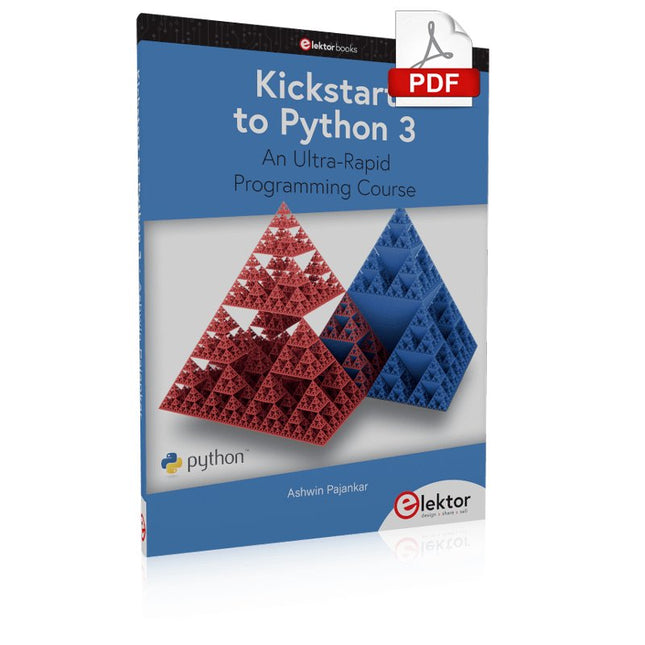
Elektor Digital Kickstart to Python 3 (E-book)
An Ultra-Rapid Programming Course This book serves as the very first step to for novices to learn Python programming. The book is divided into ten chapters. In the first chapter, readers are introduced to the basics of Python. It has the detailed instructions for installation on various platforms such as macOS, Windows, FreeBSD, and Linux. It also covers the other aspects of Python programming such as IDEs and Package Manager. The second chapter is where the readers get an opportunity to have a detailed hands-on with Python programming. It covers a group of built-in data structures popularly known as Python Collections. The third chapter covers the important concepts of strings, functions, and recursion. The fourth chapter focuses on the Object-Oriented Programming with Python. The fifth chapter discusses most commonly used custom data structures such as stack and queue. The sixth chapter spurs the creativity of the readers with Python’s Turtle graphics library. The seventh chapter explores animations and game development using the Pygame library. The eighth chapter covers handling data stored in a variety of file formats. The ninth chapter covers the area of Image processing with Wand library in Python. The tenth and the final chapter presents an array of assorted handy topics in Python. The entire book follows a step-by-step approach. The explanation of the topic is always followed by a detailed code example. The code examples are also explained in suitable detail and they are followed by the output in the form of text or screenshot wherever possible. Readers will become comfortable with Python programming language by closely following the concepts and the code examples in this book. The book also has references to external resources for readers to explore further. A download of the software code, and links to tutorial videos can be found on the Elektor website.
€ 29,95
Membres € 23,96
-

Elektor Digital Learning Python with Raspberry Pi (E-book)
This book is about teaching the Python programming language using the Raspberry Pi 4 computer. The book makes an introduction to Raspberry Pi 4 and then teaches Python with the topics: variables, strings, arrays, matrices, tuples, lists, dictionaries, user functions, flow of control, printing, keyboard input, graphics, GUI, object oriented programming and many more topics. The book is aimed for beginners, students, practising engineers, hobbyists, and for anyone else who may want to learn to program in Python. The book includes many example programs and case studies. All the example programs and case studies have been tested fully by the author and are all working. The example programs aim to teach the various programming concepts of Python. The case studies cover the use of Python in the analysis and design of electronic circuits. Some of the case study topics are: Resistor colour code identification Resistive potential divider circuits Resistive attenuator design Zener diode voltage regulator design RC and RLC transient circuits Circuit frequency response Saving data on external memory stick Mesh and node circuit analysis using matrices Resonance in RLC circuits Transistor Biasing analysis Transistor amplifier design Design of active filters Interfacing hardware with GPIO, I²C and SPI Using Wi-Fi with Python and TCP/IP and UDP programs Using Bluetooth from Python Full program listings of all the programs used in the book are available at the Elektor website of the book. Readers should be able just to copy and use these programs in their Raspberry Pi projects without any modifications.
€ 32,95
Membres € 26,36
-

Arduino Arduino Science Kit Rev3
Débloquez un monde d'apprentissage interactif grâce au matériel et au logiciel du Science Kit R3. Avec l'Arduino Nano RP2040 Connect, l'Arduino Science Carrier R3 et un grand nombre de capteurs à votre disposition, vous aurez tout ce qu'il faut pour vous embarquer dans un voyage pédagogique exaltant. Pendant ce temps, l'application Science Journal comble sans effort le fossé entre la théorie et la pratique, en facilitant la collecte, l'enregistrement et l'interprétation des données en temps réel. Le kit élève l'expérience d'apprentissage en favorisant une meilleure compréhension des concepts physiques complexes grâce à des expériences pratiques engageantes. Débloquez un monde d'apprentissage interactif grâce au matériel et au logiciel du Science Kit R3. Avec l'Arduino Nano RP2040 Connect, l'Arduino Science Carrier R3 et un grand nombre de capteurs à votre disposition, vous aurez tout ce qu'il faut pour vous embarquer dans un voyage pédagogique exaltant. Pendant ce temps, l'application Science Journal comble sans effort le fossé entre la théorie et la pratique, en facilitant la collecte, l'enregistrement et l'interprétation des données en temps réel. Ce kit améliore l'expérience d'apprentissage en favorisant une meilleure compréhension des concepts physiques complexes par le biais d'une expérimentation pratique attrayante. Il promeut la culture scientifique et renforce l'esprit critique en proposant des scénarios d'application dans le monde réel. Grâce à son guide intuitif, les enseignants et les élèves peuvent naviguer facilement à travers les explorations scientifiques. Caractéristiques Apprentissage expérimental pratique : réalisez des expériences physiques, transformant des concepts physiques abstraits en expériences tangibles et interactives. Collecte et analyse de données en temps réel : Grâce à l'intégration de l'application Science Journal, le kit permet aux élèves de collecter, d'enregistrer et d'interpréter des données en temps réel à l'aide d'appareils mobiles, renforçant ainsi leur maîtrise des données et leurs compétences en matière de recherche scientifique. Conception pratique pour l'enseignant et l'élève : équipé d'un programme préchargé, le kit ne nécessite aucune connaissance préalable en matière de codage ou d'électronique. Il est également doté d'une connectivité Bluetooth pour faciliter la transmission des données entre la carte Arduino et les téléphones mobiles des élèves. Un éventail de capteurs complet : le kit est livré avec plusieurs capteurs, ce qui offre un large panel de possibilités de collecte de données et lui permet de s'adapter à l'évolution des besoins éducatifs. Cours guidés gratuits - Explorer la physique : comprend un guide de cours intuitif qui aide les enseignants et les élèves à utiliser le kit, à présenter et à analyser les données, et à évaluer les résultats expérimentaux. Ces cours aident également les élèves à communiquer leurs découvertes scientifiques. Un soutien pédagogique complet : grâce à son guide intuitif, le kit Science Arduino R3 facilite le processus d'enseignement pour les professeurs. Il ne se contente pas d'enseigner l'utilisation du kit, mais aide également à la présentation, à l'analyse et à l'évaluation des données, ce qui permet aux élèves de communiquer leurs découvertes scientifiques. Caractéristiques techniques Matériel Arduino Nano RP2040 Connect Arduino Science Carrier R3 Capteurs intégrés : Qualité de l'air, température, humidité et pression IMU : accéléromètre linéaire à 6 axes, gyroscope et magnétomètre Proximité, lumière ambiante, couleur de la lumière Tension ou différence de potentiel électrique Courant électrique Résistance électrique Générateurs de fonctions pour voir et entendre l'effet de la fréquence, de l'amplitude et de la phase sur une onde sonore Capteur d'intensité du son ambiant Ports 2 Entrées analogiques Grove (pour un capteur de température externe) 2 Ports I²C Grove (pour le capteur externe de distance et d'écho-pince) 1x Connecteur JST pour la batterie 2x Ports de sortie connectés aux signaux de faible puissance des générateurs de fonctions (future génération) 1x Port de sortie 3,3 V et mise à la terre 2x Ports de haut-parleur connectés aux générateurs de fonctions Autre Câble de 50 cm (bleu) avec pince crocodile d'un côté, fiche banane de l'autre Câble de 50 cm (jaune) avec pinces crocodiles à une extrémité, fiche banane à l'autre. Câble de 20 cm (noir) avec pince crocodile d'un côté, fiche banane de l'autre Câble de 20 cm (rouge) avec pince crocodile d'un côté, fiche banane de l'autre Bandes VELCRO Supports en silicone Sonde de température externe Capteur de distance à ultrasons Câble Grove 4-contacts de 20 cm Câble USB-C 2x Haut-parleurs Câble pour support de batterie avec connecteur JST Support de piles pour quatre piles 1V5 AA
€ 239,00€ 179,95
Membres identique
-

Elektor Publishing Arduino for Radio Amateur Applications
Program and build Arduino-based ham station utilities, tools, and instruments In addition to a detailed introduction to the exciting world of the Arduino microcontroller and its many variants, this book introduces you to the shields, modules, and components you can connect to the Arduino. Many of these components are discussed in detail and used in the projects included in this book to help you understand how these components can be incorporated into your own Arduino projects. Emphasis has been placed on designing and creating a wide range of amateur radio-related projects that can easily be built in just a few days. This book is written for ham radio operators and Arduino enthusiasts of all skill levels, and includes discussions about the tools, construction methods, and troubleshooting techniques used in creating amateur radio-related Arduino projects. The book teaches you how to create feature-rich Arduino-based projects, with the goal of helping you to advance beyond this book, and design and build your own ham radio Arduino projects. In addition, this book describes in detail the design, construction, programming, and operation of the following projects: CW Beacon and Foxhunt Keyer Mini Weather Station RF Probe with LED Bar Graph DTMF Tone Encoder DTMF Tone Decoder Waveform Generator Auto Power On/Off Bluetooth CW Keyer Station Power Monitor AC Current Monitor This book assumes a basic knowledge of electronics and circuit construction. Basic knowledge of how to program the Arduino using its IDE will also be beneficial.
€ 39,95
Membres € 35,96
-
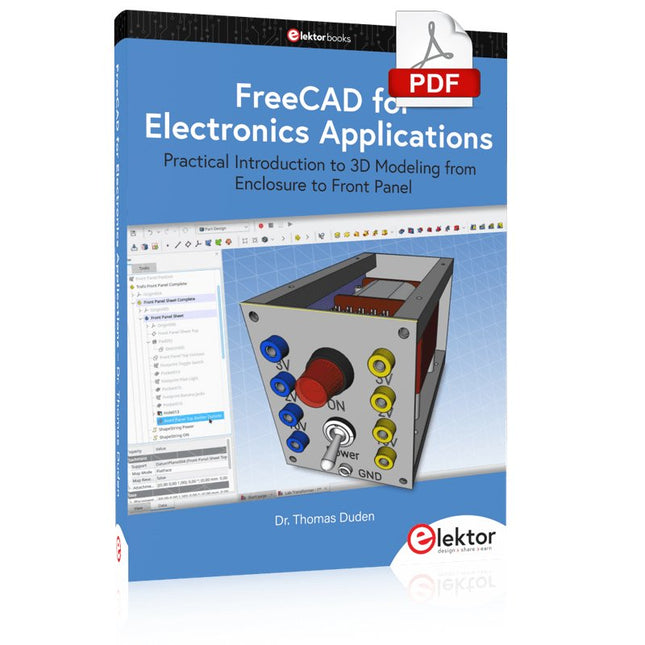
Elektor Digital FreeCAD for Electronic Applications (E-book)
Practical Introduction to 3D Modeling from Enclosure to Front Panel Embedding a vintage component, creating a professional looking home for a circuit board, or even designing a complex apparatus complete with a chassis – these and many other challenges turn into a stimulating pleasure with FreeCAD. Once you have internalized the basic processes, there are virtually no limits to your imagination. Starting to use a new software is never straightforward – especially with a tool as versatile as FreeCAD. Manageable, but at the same time easily usable individual components provide the starting point in this book. Putting these components together later results in assemblies. In the FreeCAD universe, a workable trajectory is demonstrated. The described procedure is illustrative so the examples are easily applied to custom tasks. The devices were made by the author and illustrated with photos. Creating a 3D design is requiring some effort but the initial investment pays off soon. Besides the impressive spatial representation of the projects, the extracted drawings yield a solid base for documentation and production. Extended FreeCAD capabilities like the unfolding of sheet metal parts enormously add to efficiency and pushes models forward into practical assembly. Soon you will definitely not want to do without FreeCAD!
€ 34,95
Membres € 27,96
-
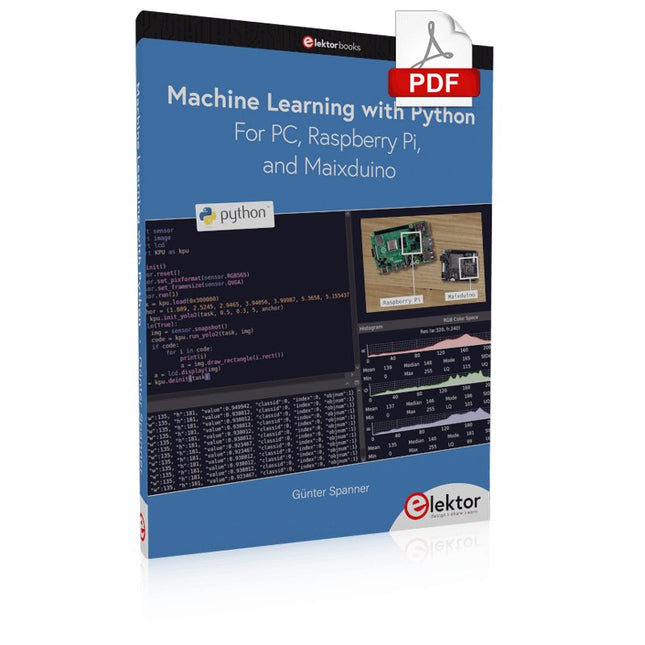
Elektor Digital Machine Learning with Python for PC, Raspberry Pi, and Maixduino (E-book)
La plupart des gens sont de plus en plus confrontés aux applications de l’intelligence artificielle (IA). Les classements de musique ou de vidéo, les systèmes de navigation, les conseils d'achat, etc. reposent sur des méthodes qui peuvent être attribuées à ce domaine. Le terme intelligence artificielle a été inventé en 1956 lors d’une conférence internationale connue sous le nom de Dartmouth Summer Research Project. Une approche fondamentale consistait à modéliser le fonctionnement du cerveau humain et à construire des systèmes informatiques avancés sur cette base. Bientôt, le fonctionnement de l’esprit humain devrait être clair. Le transférer sur une machine n’était considéré qu’une petite étape. Cette notion s'est avérée un peu trop optimiste. Néanmoins, les progrès de l’IA moderne, ou plutôt de sa sous-spécialité appelée Machine Learning (ML), ne peuvent plus être niés. Dans ce livre, plusieurs systèmes différents seront utilisés pour connaître plus en détail les méthodes d’apprentissage automatique. En plus du PC, le Raspberry Pi et le Maixduino démontreront leurs capacités dans les différents projets. Outre des applications telles que la reconnaissance d'objets et de visages, des systèmes pratiques tels que des détecteurs de bouteilles, des compteurs de personnes ou un « œil qui parle » seront également créés. Ce dernier est capable de décrire acoustiquement des objets ou des visages détectés automatiquement. Par exemple, si un véhicule se trouve dans le champ de vision de la caméra connectée, l'information « Je vois une voiture ! est émis via une parole générée électroniquement. De tels appareils sont des exemples très intéressants de la manière dont, par exemple, les personnes aveugles ou gravement malvoyantes peuvent également bénéficier des systèmes d’IA.
€ 32,95
Membres € 26,36
-

Elektor Digital Arduino for Radio Amateur Applications (E-book)
Program and build Arduino-based ham station utilities, tools, and instruments In addition to a detailed introduction to the exciting world of the Arduino microcontroller and its many variants, this book introduces you to the shields, modules, and components you can connect to the Arduino. Many of these components are discussed in detail and used in the projects included in this book to help you understand how these components can be incorporated into your own Arduino projects. Emphasis has been placed on designing and creating a wide range of amateur radio-related projects that can easily be built in just a few days. This book is written for ham radio operators and Arduino enthusiasts of all skill levels, and includes discussions about the tools, construction methods, and troubleshooting techniques used in creating amateur radio-related Arduino projects. The book teaches you how to create feature-rich Arduino-based projects, with the goal of helping you to advance beyond this book, and design and build your own ham radio Arduino projects. In addition, this book describes in detail the design, construction, programming, and operation of the following projects: CW Beacon and Foxhunt Keyer Mini Weather Station RF Probe with LED Bar Graph DTMF Tone Encoder DTMF Tone Decoder Waveform Generator Auto Power On/Off Bluetooth CW Keyer Station Power Monitor AC Current Monitor This book assumes a basic knowledge of electronics and circuit construction. Basic knowledge of how to program the Arduino using its IDE will also be beneficial.
€ 32,95
Membres € 26,36
-

Elektor Publishing Programming Voice-controlled IoT Applications with Alexa and Raspberry Pi
Learn programming for Alexa devices, extend it to smart home devices and control the Raspberry Pi The book is split into two parts: the first part covers creating Alexa skills and the second part, designing Internet of Things and Smart Home devices using a Raspberry Pi. The first chapters describe the process of Alexa communication, opening an Amazon account and creating a skill for free. The operation of an Alexa skill and terminology such as utterances, intents, slots, and conversations are explained. Debugging your code, saving user data between sessions, S3 data storage and Dynamo DB database are discussed. In-skill purchasing, enabling users to buy items for your skill as well as certification and publication is outlined. Creating skills using AWS Lambda and ASK CLI is covered, along with the Visual Studio code editor and local debugging. Also covered is the process of designing skills for visual displays and interactive touch designs using Alexa Presentation Language. The second half of the book starts by creating a Raspberry Pi IoT 'thing' to control a robot from your Alexa device. This covers security issues and methods of sending and receiving MQTT messages between an Alexa device and the Raspberry Pi. Creating a smart home device is described including forming a security profile, linking with Amazon, and writing a Lambda function that gets triggered by an Alexa skill. Device discovery and on/off control is demonstrated. Next, readers discover how to control a smart home Raspberry Pi display from an Alexa skill using Simple Queue Service (SQS) messaging to switch the display on and off or change the color. A node-RED design is discussed from the basic user interface right up to configuring MQTT nodes. MQTT messages sent from a user are displayed on a Raspberry Pi. A chapter discusses sending a proactive notification such as a weather alert from a Raspberry Pi to an Alexa device. The book concludes by explaining how to create Raspberry Pi as a stand-alone Alexa device.
€ 39,95
Membres € 35,96
-
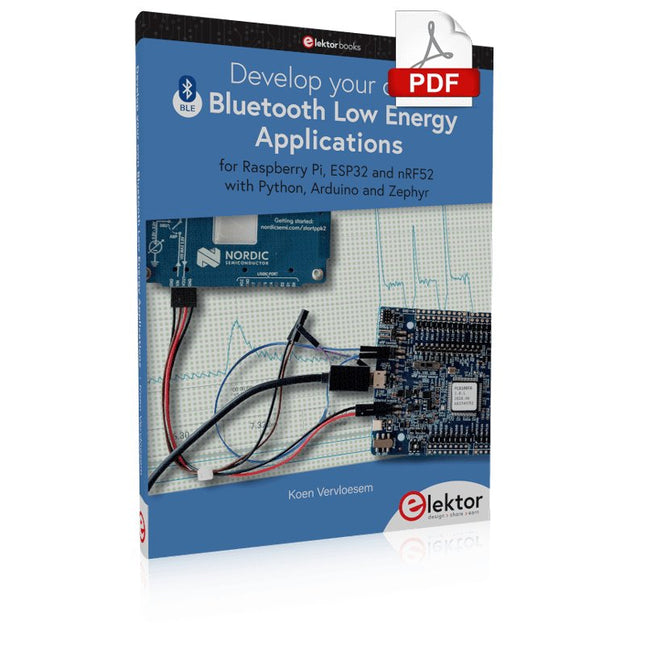
Elektor Digital Develop your own Bluetooth Low Energy Applications (E-book)
For Raspberry Pi, ESP32 and nRF52 with Python, Arduino and Zephyr Bluetooth Low Energy (BLE) radio chips are ubiquitous from Raspberry Pi to light bulbs. BLE is an elaborate technology with a comprehensive specification, but the basics are quite accessible. A progressive and systematic approach will lead you far in mastering this wireless communication technique, which is essential for working in low power scenarios. In this book, you’ll learn how to: Discover BLE devices in the neighborhood by listening to their advertisements. Create your own BLE devices advertising data. Connect to BLE devices such as heart rate monitors and proximity reporters. Create secure connections to BLE devices with encryption and authentication. Understand BLE service and profile specifications and implement them. Reverse engineer a BLE device with a proprietary implementation and control it with your own software. Make your BLE devices use as little power as possible. This book shows you the ropes of BLE programming with Python and the Bleak library on a Raspberry Pi or PC, with C++ and NimBLE-Arduino on Espressif’s ESP32 development boards, and with C on one of the development boards supported by the Zephyr real-time operating system, such as Nordic Semiconductor's nRF52 boards. Starting with a very little amount of theory, you’ll develop code right from the beginning. After you’ve completed this book, you’ll know enough to create your own BLE applications.
€ 32,95
Membres € 26,36











